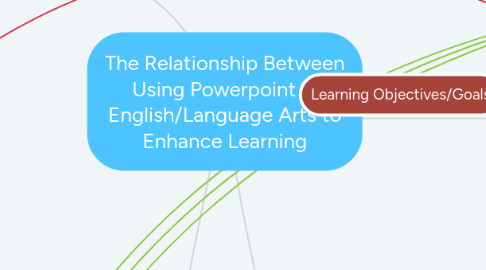
1. Learning Activities
1.1. Group Work
1.1.1. Research using scholarly sources
1.1.2. Build background knowledge on the format
1.1.3. Start with a fresh powerpoint
1.1.4. Brainstorm all topics that could be included within the powerpoint
1.1.5. Create slides
1.1.6. Add in transitions
1.1.7. Re-order slides if needed
1.1.8. Edit and revise
1.1.9. Save project
1.1.10. Present project as a group
1.2. Individual Work
1.2.1. Have students pick their own topic
1.2.2. Have students do research
1.2.3. Students create own powerpoint based on personal notes
1.2.4. Have students present individually
2. Learning Assessment
2.1. Formative Assessment
2.1.1. Create a pre-test for students to take regarding content
2.1.2. Have discussions throughout the learning process about using powerpoint
2.1.3. Create a survey for students to take during the learning process/powerpoint creating process
2.1.4. Have students keep a "learning log" of how the powerpoint creation is going
2.2. Summative Assessment
2.2.1. Have students present their powerpoints to the class
2.2.2. Use a scoring guide during the assessment to make notes
2.2.3. Use a completed scoring guide to grade students
2.2.4. Students can also use a scoring guide to assess each other which facilitates further learning.
3. Connections in red have to do with creating the powerpoint. Creations can happen in either groups or individuals. Teachers should manage creations, but also motivate students.
4. Teacher Roles
4.1. Model
4.1.1. Define PowerPoint
4.1.2. Create an example presentation
4.1.3. Describe how to use PowerPoint
4.2. Organizer
4.2.1. Either have students create powerpoint individually, or split class into groups
4.2.2. Organize materials
4.3. Motivator
4.3.1. Create exciting lessons
4.3.2. Help students set goals
4.4. Manager
4.4.1. Manage time spent on each goal
4.4.2. Make sure students are staying on task
4.4.3. Make sure meaningful learning is occuring
4.5. Assessor
4.5.1. Record using a scoring guide as students present
4.6. Evaluator
4.6.1. Assign grades to students using records from assessment
5. Learning Objectives/Goals
5.1. Create
5.1.1. Give students a rubric, prompt, scoring guide, materials, resources, examples, etc. so that they may successfully create their project.
5.1.2. Using powerpoint, have students construct a new presentation from a blank template.
5.2. Present
5.2.1. Give students a scoring guide so that they may peer-evaluate.
5.2.2. Give students resources to read on how to become a better presenter
5.2.3. Have students present project keeping in mind curriculum.
